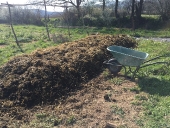Concerning your mature trees the traditional thing to do with the slash or fallen branches is to burn it because it's a waste stream that shrinks in fire. But I'd propose it's a resource as fungi food. If you chop it up and get it to make good contact with your forest soil it won't be a fire liability or as bulky after the soil food web works it over. Oregon commercial orchards are regulated by states laws (like deq or something--I aint an expert) I assume because of what they use for inputs. But what do forests have for inputs other than light air and water? Fungi recycled plant food big time, and bacteria and animal recycled matter too. I'm pretty sure one of the winning facets of hugelculture is the fungi working in the background.
So some things to think about for your big picture context. Do you have loam or clay soil? The loam meets that description pretty much every fruit tree for sale wants "well drained" and it warms up a little faster than clay in the spring. Both types of soil benefit from fungi but what you have to work with will inform what you do to improve it over the years. For instance if you are in clay there are fruit tree rootstocks that will do better than others there. If you're in mixed douglas fir hardwoods you might have the acidic ph already to grow blueberries easy-mode. But if you read about it on the internet and skipped getting a soil test before you start then you might think you need to supplement Sulphur, wait a year, ph test, then plant them, then buy acid-loving plant fertilizer. Maybe, but maybe not the way to go. My soil test recommended I do dolomitic lime. I have; not at the blueberries, but at pretty much everything else. My soil was very low N and K and low P, 38 inches of rain a year so I suppose the more water soluble stuff is lost to the water cycle. I've added lots of woodchips and goat manure because I think it will address and help what I have to work with. Looking forward to my second soil test this fall.
I recommend blueberries in your wettest location if it gets enough light and you have naturally acidic soil. It is the most water dependent bush we grow at 2" per week, but the berries are a super food. A rhubarb maybe two if you really like them in your future drip line in other words centered between fruit trees future bigger shade. Picture them taking up a little less than 3'x'3'x2' each. Hybrid comfrey in similar spaces a couple feet away from your trees *
if* you are sure you won't need to relocate it. They get taller but not as broad as the rhubarb. You will be mad at me if you plant comfrey and then need to dig it up and try to remove it. But it's
compost activator, strawberry mulch, medicinal, animal fodder. I recommend asparagus in a drier place that you can leave it for 25 years. It has deep roots tall ferns low labor early season yield after the 3 year investment. Spring mushrooms, rhubarb, and asparagus are first yields here. And strawberries if you can provide them enough southern exposure so they can get full light despite the nearby trees or maybe in a damp spot with more than half light so they get plenty of water. They like 1 1/2" per week. Companion to strawberry is borage and marigold. A friend of ours has hardi kiwi trellise it's gorgeous up above head height and productive. I went copy it and lost two female vines to voles. I would also add daffodils if you like their looks. Might help with gophers and voles, might not. Thick mulch, watered happy plants, compost and vibrant earthworm populations unfortunately draw in these things from the wild as part of the system.
If you have 100 day drought summers like I do then I would invest in a serious drip system with buried pvc. It fits your easier goal after the initial pain in the lower back investment. They make special narrow shovels for trenching, and reject sand for protecting the buried pipes before backfilling is cheap insurance against rock damage. We had a thrown together drip irrigation last summer, and haven't gotten around to fixing it this year. And I'm out of town on a trip and my wife has an emergency to deal with. The trees and deep tap rooted perennials will be fine until she gets to them, but there is a real life case to be made for the easy-mode plants.





























